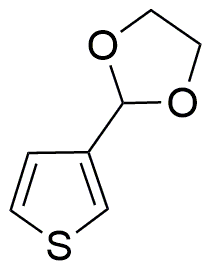2-(3-Thienyl)-1,3-dioxolane is widely utilized in research focused on:
- Organic Synthesis: This compound serves as a valuable intermediate in the synthesis of various organic molecules, particularly in the development of pharmaceuticals and agrochemicals.
- Electronics: It is used in the production of organic semiconductors, which are essential for developing flexible electronic devices, such as organic light-emitting diodes (OLEDs).
- Material Science: The compound is explored for its potential in creating advanced materials with unique properties, including conductivity and stability, beneficial for coatings and composites.
- Biological Research: Researchers are investigating its role in biological systems, particularly in drug design, where it may enhance the efficacy of certain therapeutic agents.
- Environmental Applications: It is being studied for its potential use in developing environmentally friendly pesticides, offering a safer alternative to traditional chemicals.
Informations générales
Propriétés
Sécurité et réglementation
Applications
2-(3-Thienyl)-1,3-dioxolane is widely utilized in research focused on:
- Organic Synthesis: This compound serves as a valuable intermediate in the synthesis of various organic molecules, particularly in the development of pharmaceuticals and agrochemicals.
- Electronics: It is used in the production of organic semiconductors, which are essential for developing flexible electronic devices, such as organic light-emitting diodes (OLEDs).
- Material Science: The compound is explored for its potential in creating advanced materials with unique properties, including conductivity and stability, beneficial for coatings and composites.
- Biological Research: Researchers are investigating its role in biological systems, particularly in drug design, where it may enhance the efficacy of certain therapeutic agents.
- Environmental Applications: It is being studied for its potential use in developing environmentally friendly pesticides, offering a safer alternative to traditional chemicals.
Documents
Fiches de données de sécurité (FDS)
La FDS fournit des informations de sécurité complètes sur la manipulation, le stockage et l’élimination du produit.
Spécifications du produit (PS)
Le PS fournit une description complète des propriétés du produit, notamment sa composition chimique, son état physique, sa pureté et les exigences de stockage. Il détaille également les plages de qualité acceptables et les applications prévues du produit.
Certificats d'analyse (COA)
Recherchez des certificats d'analyse (COA) en saisissant le numéro de lot du produit. Les numéros de lot et de lot se trouvent sur l'étiquette d'un produit, après les mots « Lot » ou « Lot de fabrication ».
Numéro de catalogue
Numéro de lot/série
Certificats d'origine (COO)
Ce certificat d'exploitation confirme le pays dans lequel le produit a été fabriqué, et détaille également les matériaux et composants utilisés et s'il est issu de sources naturelles, synthétiques ou autres sources spécifiques. Ce certificat peut être requis pour les douanes, le commerce et la conformité réglementaire.
Numéro de catalogue
Numéro de lot/série
Fiches de données de sécurité (FDS)
La FDS fournit des informations de sécurité complètes sur la manipulation, le stockage et l’élimination du produit.
DownloadSpécifications du produit (PS)
Le PS fournit une description complète des propriétés du produit, notamment sa composition chimique, son état physique, sa pureté et les exigences de stockage. Il détaille également les plages de qualité acceptables et les applications prévues du produit.
DownloadCertificats d'analyse (COA)
Recherchez des certificats d'analyse (COA) en saisissant le numéro de lot du produit. Les numéros de lot et de lot se trouvent sur l'étiquette d'un produit, après les mots « Lot » ou « Lot de fabrication ».
Numéro de catalogue
Numéro de lot/série
Certificats d'origine (COO)
Ce certificat d'exploitation confirme le pays dans lequel le produit a été fabriqué, et détaille également les matériaux et composants utilisés et s'il est issu de sources naturelles, synthétiques ou autres sources spécifiques. Ce certificat peut être requis pour les douanes, le commerce et la conformité réglementaire.


